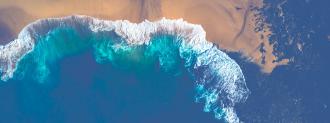What color is the ocean? Obviously blue, right?
Not always — and different colors are indicators of ocean health. Clear water, deep enough where the seafloor isn’t visible, will always appear blue because of how water absorbs and scatters light.
But not all water is pure and deep. Sand runoff, phytoplankton, or pollution can hint at other colors like green or brown.
Researchers have long relied on the water’s color to assess the state of the ocean. Now, a team from Stevens Institute of Technology has developed a machine-learning platform, called OC-SMART, that can rapidly process ocean color from satellite images — giving scientists valuable information on ocean health.
“OC-SMART is a general, all-purpose, easy-to-use platform,” Wei Li, a physicist at Stevens who worked on the project, said in a statement.
Their work, which NASA will adopt, is one of the first platforms that can assess coastal and open ocean water to give a comprehensive picture of ocean health and how climate change impacts our water planet.
For decades, NASA has been using a platform called SeaDAS to analyze water color and assess ocean health. But it was only effective with an open ocean below a blanket of clean air. The land/sea interface often presented muddied data and inaccurate results because of the interaction between land, the deep sea, light reflections, and atmosphere.
The new program, which they outlined in the journal Remote Sensing of Environment, is designed to cut through the noise and get more precise results.
“It is vital to study coastal areas and inland waters,” said Knut Stamnes, a physicist at Stevens. “Even though these areas make up a small fraction of the world in terms of mass, it’s where we live and where all the biological activity happens.”
The OC-SMART is one of the first of these programs to use machine learning algorithms, the team reports. By processing satellite imagery data, it analyzes radiative transfer — the flow of energy between the ocean and atmosphere.
The final outputs include data on chlorophyll concentrations, the presence of phytoplankton, pollution concentrations, and other helpful indicators of ocean health.
Phytoplankton concentration, especially, is a growing interest for understanding climate and ocean health because of its impact on the Earth’s systems. The tiny organisms transform carbon dioxide into oxygen, a process that can impact climate change. Since phytoplankton populations can multiply rapidly, it is important to assess them continually.
“There are satellites now in orbit that are giving us more information on what’s going on around the coasts and in places like the big lakes,” said Stamnes. “So, this opens new areas of research. And with machine learning, it’s a whole new game.”
We’d love to hear from you! If you have a comment about this article or if you have a tip for a future Freethink story, please email us at [email protected].





